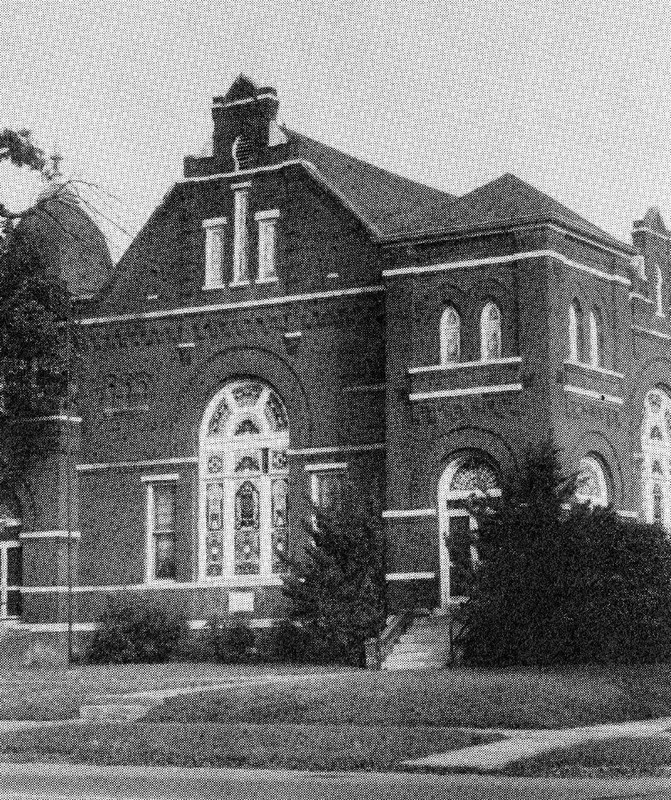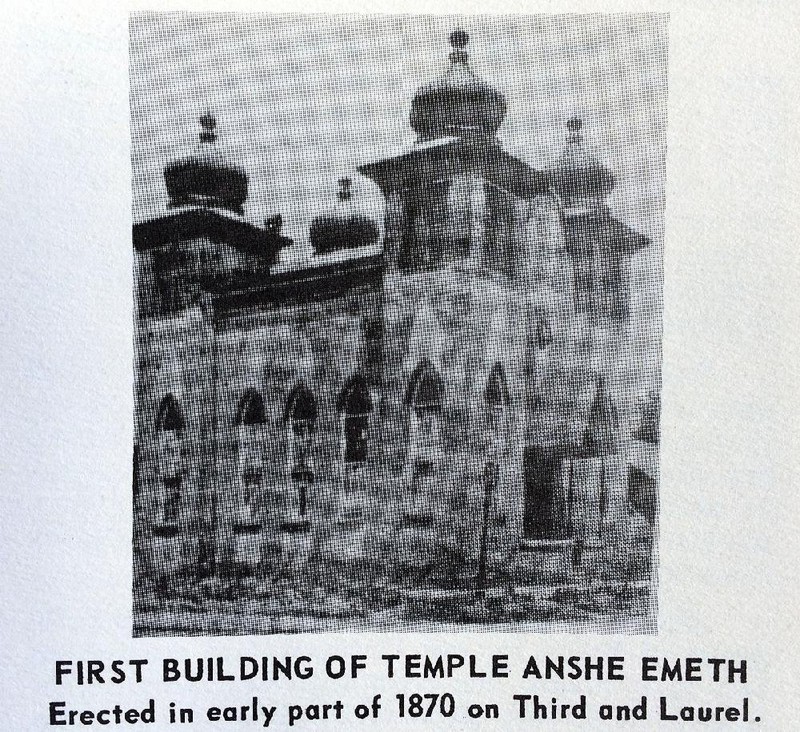Congregation Anshe Emeth, currently True Vine "E" Missionary Baptist Church
Introduction
Text-to-speech Audio
Congregation Anshe Emeth was Pine Bluff's first synagogue and was founded in 1870 with a building at Third and Laurel Streets. This structure was built to be the second location for the congregation, and their synagogue opened in 1902, a time that saw a dramatic increase in membership that corresponded with Jewish immigration. The congregation enjoyed a steady rise in membership as Jews continued to arrive from Eastern Europe, but membership plateaued in World War I and the 1920s when the war and subsequent immigration quotas saw a decline in immigration. Even as membership declined, Anshe Emeth's laypeople and leaders were involved in their town's social issues, speaking out against racism and religious tensions. Anshe Emeth closed its doors in 2016 following years of declining membership and the structure is now home to a Baptist congregation.
Images
A postcard depicting Congregation Anshe Emeth's second location

Old photo of Congregation Anshe Emeth's second location

Anshe Emeth's first building, 1870-1902, at Third and Laurel Streets

Backstory and Context
Text-to-speech Audio
Jews have lived in Pine Bluff since before the town was incorporated in the 1840s. A congregation didn't form until after the Civil War when members began holding small services in their homes. The town's first synagogue, a Moorish building with domes on the roof, was built in 1870 at Third and Laurel Streets. They quickly outgrew this building near the turn of the century following a spike in population. This was also the time Pine Bluff also experienced a rise in Eastern European Jewish immigration, and although some of these more observant Jews founded their own Orthodox congregation, B'nai Israel, a handful joined Anshe Emeth. In 1902, Anshe Emeth moved to a larger brick building at 2nd Avenue and Poplar Street.
When restrictive immigration quotas were introduced in the 1920s, throttling the number of Jews allowed to come to the United States, B'nai Israel began to decline. Some of their second-generation members, who tended to assimilate more than their parents, joined Anshe Emeth, finding the more liberal Reform denomination a better fit. B'nai Israel officially disbanded in 1950, leading Anshe Emeth to experience a slight rise in membership as any remaining Orthodox Jews joined them. However, the Jewish population in Pine Bluff had dropped overall in the previous decades, especially after World War II. This led the congregation to purchase a smaller lot on the corner of 40th and Hickory Streets, near where most members now lived. After six years of fundraising, Anshe Emeth's final building opened in 1967.
Pine Bluff had many rabbis over the years. Some of them were controversial figures, such as Rabbi Ephraim Frisch, who served the congregation from 1904-1912. Frisch, a first-generation immigrant from Lithuania, was an outspoken critic of Christian displays in public spaces, and he drew some public ire after criticizing the governor of Arkansas for references to Christianity in his Thanksgiving speech. He was also liberal when it came to race, befriending Isaac Fischer, a local black leader, despite the deep-seated racism that has been common in the South. Frisch's successor, Rabbi Leonard Rothstein, not only made changes to the congregation's operations but followed his predecessor's example in speaking out against social issues. Especially notable is the time he publicly criticized the Pine Bluff school board for letting a representative of the Ku Klux Klan speak at a local high school.
Membership in this Cotton Belt synagogue dropped after the 1970s. There were several close calls over the years as the congregation barely managed to keep afloat. According to a longtime member, the congregation lasted for so long because those who stayed members were local business owners and other established community members. Their children, however, wanted a larger Jewish community, seeking them out in places like Dallas, St. Louis, and Atlanta, leaving Pine Bluff behind. By the 1980s, Anshe Emeth also no longer had their own rabbi, relying on rabbinical students from Cincinnati's Hebrew Union Seminary to lead their services, which were only held once a month. The congregation sold its building in 2004, moving services to rented space in a local church until finally closing its doors in 2016. More than 50 people attended the closing ceremony at the 2nd Avenue building, many of them former residents. The congregation's two Torahs were sent to other synagogues, one in Israel and the other in Guatemala. The synagogue's second iteration is a church today, and the third was sold to nearby Jefferson Medical Center.
Cite This Entry
Rieber, Ellie and Clio Admin. "Congregation Anshe Emeth, currently True Vine "E" Missionary Baptist Church." Clio: Your Guide to History. June 2, 2023. Accessed March 31, 2025. https://theclio.com/entry/160784
Sources
PINE BLUFF, AR ~ CONGREGATION ANSHE EMETH (1902), Synagogues of the South. Accessed May 26th, 2023. https://synagoguesofthesouth.cofc.edu/synagogues/pine-bluff-ar-congregation-anshe-emeth-1902/.
Temple Anshe Emeth Pine Bluff, Arkansas, Free Pages. Accessed May 26th, 2023. https://freepages.rootsweb.com/~ssjdb/genealogy/PB.htm.
Storm, Christie. Saying Farewell, Arkansas Democrat Gazette. June 4th, 2016. Accessed May 26th, 2023. https://www.arkansasonline.com/news/2016/jun/04/saying-farewell-20160604/.
Jaben-Eilon, Jan. Matchmaker, Matchmaker, Match My Torah!, Tablet. July 12th, 2016. Accessed May 26th, 2023. https://www.tabletmag.com/sections/community/articles/donating-torahs.
Encyclopedia of Southern Jewish Communities - Congregations - Pine Bluff, Arkansas, ISJL. Accessed May 26th, 2023. https://www.isjl.org/arkansas-pine-bluff-congregations-encyclopedia.html.
Synagogues of the South
Arkansas Democrat Gazette
Arkansas Democrat-Gazette

